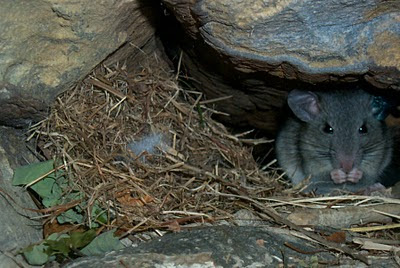There are dozens of non-game mammal species found in New Jersey. Of these, there are only three land mammal species listed as "endangered." They are the bobcat, Indiana bat and Allegheny Woodrat.
The state-endangered Eastern woodrats have been declining at an alarming rate throughout the northeastern portion of their range. The decline has been attributed, at least in part, to the parasite, raccoon roundworm. NJ's last remaining eastern woodrat (Neotoma floridana) population is at the Palisades Interstate Park in Bergen County.
The Allegheny woodrat, Neotoma magister, is a species of "pack rat" in the genus Neotoma. Once believed to be a subspecies of the Eastern Woodrat or Florida Woodrat, extensive DNA analysis has proven it to be a distinct species.
 |
| Photo: http://science.nature.nps.gov |
The Allegheny Woodrat prefers rocky outcrops associated with mountain ridges such as cliffs, caves, talus slopes, and even mines. This is mostly true for Pennsylvania and Maryland. In Virginia and West Virginia, woodrats are found on ridges but also on side slopes in caves and talus (boulders and breakdown) fields. The surrounding forest is usually deciduous
Distribution mainly occurs along the Appalachian Mountain range. Historically found as far north as Connecticut where it is now extinct, southeastern New York (near extinct), northern New Jersey, and northern Pennsylvania southwestward through western Maryland, Tennessee, Kentucky, West Virginia, northern and western Virginia to northeastern Alabama and northwestern North Carolina with isolated populations north of the Ohio River in southern Ohio and southern Indiana. The Tennessee River is generally accepted as the southern range limit.
Although the Allegheny Woodrat is not federally listed, it is in major decline and is state listed. In parts of their range (New York, New Jersey, and Pennsylvania), the Allegheny Woodrat population has been in decline over the past thirty years. A decline in populations of Allegheny woodrats was first noticed in the 1980s. Since that time, woodrats have become extirpated from at least two states and have declined dramatically in several others. Recent evidence suggests that the decline of this species may be proceeding further south to include states where woodrat populations were previously considered to be stable.
The Allegheny Woodrat prefers rocky outcrops associated with mountain ridges such as cliffs, caves, talus slopes (boulders and breakdown), and even mines.
The Allegheny Woodrat's diet primarily consists of plant materials including buds, leaves, stems, fruits, seeds, acorns and other nuts. They store their food in caches and eat about five percent of their body weight a day.
They also collect and store various non-food items such as bottle caps, snail shells, coins, gun cartridges, feathers and bones. This trait is responsible for the nickname "trade" or "pack rat".
These rats form small colonies in which their nesting areas consist of a network of underground runways. They also create "latrines" - large fecal piles the rats deposit on protected flat rocks.
Researchers have found dried leaves placed around the nesting area which appear to act as alarms to warn the rats of approaching danger.
Unlike their cousins, the Allegheny Woodrat (Neotoma magister) is not a prolific breeder, averaging only one to three young per litter. In the wild, the Allegheny Woodrat has been known to live up to three years.
Predators include owls, skunks, weasels, foxes, raccoons, bobcats, large snakes and, of course, humans. At one point, the Allegheny rat was hunted for food and also killed due to false identification based on its resemblance of more problematic European rats. The Allegheny woodrat is most easily distinguished from the Norway rat by its larger, naked ears and its hairy, bicolor tail that is dark gray above and white below.
The NJ ENSP conducts annual monitoring of the Palisade population via live-trapping during the early fall. Trapping results indicate that this population has remained stable. Annual monitoring of this population has become a priority due to the rapid decline and extirpation of the species from their former range in New York and portions of eastern Pennsylvania.
More Information
On New Jersey's only remaining Allegheny woodrat population at the Hudson River Palisades NJ's Allegheny Woodrat Fact Sheet (pdf, 59kb)
The Allegheny Woodrat: Ecology, Conservation, and Management of a Declining Species
http://www.iucnredlist.org/apps/redlist/details/14581/0
No comments:
Post a Comment